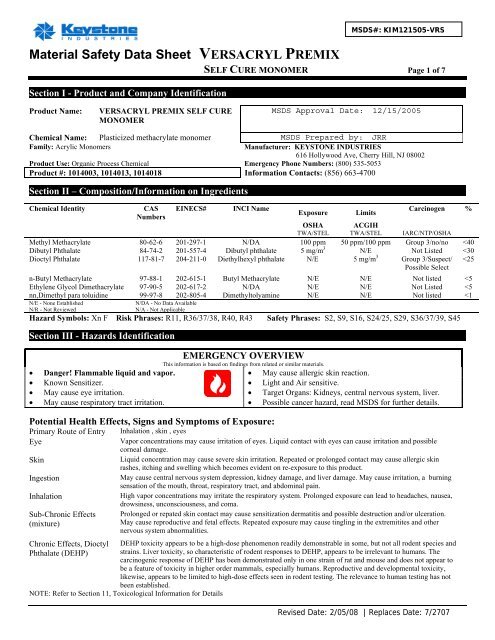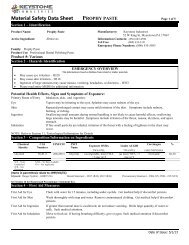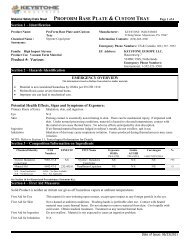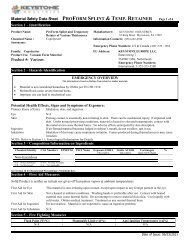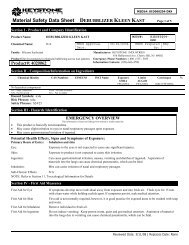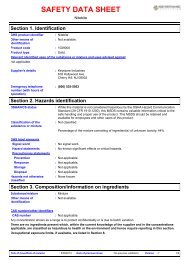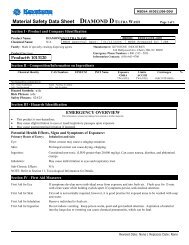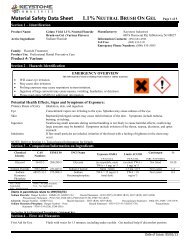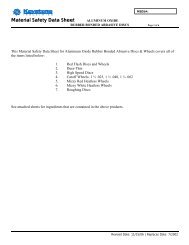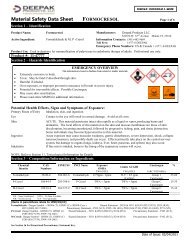Versacryl Reline Heat Cure Monomer MSDS - Keystone Industries
Versacryl Reline Heat Cure Monomer MSDS - Keystone Industries
Versacryl Reline Heat Cure Monomer MSDS - Keystone Industries
You also want an ePaper? Increase the reach of your titles
YUMPU automatically turns print PDFs into web optimized ePapers that Google loves.
Material Safety Data Sheet VERSACRYL PREMIX<br />
<strong>MSDS</strong>#: KIM121505-VRS<br />
SELF CURE MONOMER Page 1 of 7<br />
Section I - Product and Company Identification<br />
Product Name:<br />
VERSACRYL PREMIX SELF CURE<br />
MONOMER<br />
<strong>MSDS</strong> Approval Date: 12/15/2005<br />
Chemical Name: Plasticized methacrylate monomer <strong>MSDS</strong> Prepared by: JRR<br />
Family: Acrylic <strong>Monomer</strong>s<br />
Manufacturer: KEYSTONE INDUSTRIES<br />
616 Hollywood Ave, Cherry Hill, NJ 08002<br />
Product Use: Organic Process Chemical Emergency Phone Numbers: (800) 535-5053<br />
Product #: 1014003, 1014013, 1014018 Information Contacts: (856) 663-4700<br />
Section II – Composition/Information on Ingredients<br />
Chemical Identity<br />
CAS EINECS# INCI Name<br />
Carcinogen %<br />
Exposure Limits<br />
Numbers<br />
OSHA ACGIH<br />
TWA/STEL TWA/STEL IARC/NTP/OSHA<br />
Methyl Methacrylate 80-62-6 201-297-1 N/DA 100 ppm 50 ppm/100 ppm Group 3/no/no
Material Safety Data Sheet VERSACRYL PREMIX<br />
<strong>MSDS</strong>#: KIM121505-VRS<br />
SELF CURE MONOMER Page 2 of 7<br />
Section IV - First Aid Measures<br />
First Aid for Eye<br />
First Aid for Skin<br />
First Aid for Inhalation<br />
First Aid for Ingestion<br />
If symptoms develop, move individual away from exposure and into fresh air. Flush eyes gently with<br />
water for at least 15 min. while holding eyelids apart. If symptoms persist or there is any visual<br />
difficulty, seek medical attention.<br />
Wash thoroughly with soap and water. Remove contaminated clothing. Get medical help if discomfort<br />
persists.Wash clothing before use.<br />
Remove to fresh air. If having breathing difficulty, give oxygen. If breathing has stopped, give<br />
artificial respiration. Get medical help if discomfort persists.<br />
Never give anything by mouth to an unconscious person. Get medial aid. Do NOT induce vomiting. If<br />
conscious and alert, rinse mouth and drink 2 to 4 cupfuls of milk or water.<br />
Section V - Fire Fighting Measures<br />
Flash Point Flammable Limit Auto-ignition Temperature<br />
(°F/°C) (vol%) (vol%)<br />
Tag Closed Cup: 51°F/10ºC LEL: 2.12%<br />
UEL: 12.5%<br />
815ºF/435ºC<br />
Method:<br />
Extinguishing Media:<br />
Fire Fighting<br />
Instructions:<br />
Unusual Hazards:<br />
Foam, Carbon Dioxide, Dry Chemical.<br />
Wear self-contained breathing apparatus and full protective gear. Water may be ineffective unless used<br />
as a fine spray or fog. Use water spray to cool the exposed containers of methacrylate monomer.<br />
Vapors may travel to source of ignition and flash back. Avoid ignition sources or excessive<br />
temperatures .<strong>Heat</strong> can induce polymerization with rapid release of energy. Closed containers<br />
may rupture explosively. Spontaneous polymerization may occur on prolonged aging.<br />
Section VI - Accidental Release Measures<br />
Spill or Release<br />
Procedures<br />
Eliminate all sources of heat and ignition. Use absorbent material for spills and dike it, wash spill<br />
material into retaining containers. Place containers in a well ventilated area. Consult an expert on<br />
disposal of recovered material and ensure conformity to local disposal regulations. Keep<br />
unnecessary and unprotected personnel from entering. Contain and recover liquid when possible. Use<br />
non-sparking tools and equipment. Collect liquid in an appropriate container or absorb with an inert<br />
material (e. g., vermiculite, dry sand, earth), and place in a chemical waste container. Do not use<br />
combustible materials, such as sawdust. Do not flush to sewer! US Regulations (CERCLA) require<br />
reporting spills and releases to soil, water and air in excess of reportable quantities. The toll free<br />
number for the US Coast Guard National Response Center is (800) 424-8802. If a leak or spill has not<br />
ignited, use water spray to disperse the vapors, to protect personnel attempting to stop leak, and to flush<br />
spills away from exposures.<br />
Section VII - Handling and Storage<br />
Handling<br />
Storage<br />
Explosion Hazard<br />
Keep away from heat, sparks, flames and other sources of ignition. Avoid contact with eyes, skin and<br />
clothing. Avoid breathing vapor or mist. Use with adequate ventilation. Ground all metal containers<br />
when transferring and use explosion-proof equipment. Follow all <strong>MSDS</strong>/label precautions even after<br />
the container is emptied because it may retain product residues. Wash thoroughly after handling.<br />
Store in a cool, dry area. Keep container closed when not in use. Store at ambient temperatures<br />
out of direct sunlight. Store in a well ventilated place. Store in accordance with National Fire<br />
Protection Association recommendations. Maintain air space inside storage containers. Inhibitor<br />
requires air (oxygen) contact to function. Check inhibitor levels after 3 months, maintain original level.<br />
Avoid ignition sources or excessive temperatures. <strong>Heat</strong> can induce polymerization with rapid<br />
release of energy. Closed containers may rupture explosively. Spontaneous polymerization may occur<br />
on prolonged aging.<br />
Revised Date: 2/05/08 | Replaces Date: 7/2707
Material Safety Data Sheet VERSACRYL PREMIX<br />
<strong>MSDS</strong>#: KIM121505-VRS<br />
SELF CURE MONOMER Page 3 of 7<br />
Section VIII - Exposure Controls / Personal Protective Equipment<br />
Engineering Controls<br />
Facilities storing or ultilizing this material should be equipped with an eye facility and safety shower.<br />
Use process enclosures local exhaust ventilation, or other engineering controls to control airborne levels<br />
below recommended exposure limits. Use explosion-proof ventilation equipment.<br />
Methyl methacrylate: IDLH = 1000 ppm via NIOSH standards.<br />
Dibutyl Phthalate: IDLH = 4000 mg/m 3 via NIOSH standards.<br />
Personal Protective Equipment<br />
General<br />
To identify additional Personal Protective Equipment (PPE) requirements, it is recommended that<br />
a hazard assessment in accordance with the OSHA PPE Standard (29CFR1910.132), or European<br />
Standard EN166 be conducted before using this product . Provide eye wash stations and safety<br />
showers. Wear impervious clothing to prevent ANY contact with this product, such as gloves,<br />
apron, boots, or whole body suit. Nitrile rubber is better than PVC.<br />
Eye/ Face Protection Wear safety glasses. Wear coverall chemical splash goggles and face shield when possibility exists for<br />
eye and face contact due to splashing or spraying material.<br />
Skin Protection<br />
Use impermeable clothing to prevent ANY contact with this product, such as gloves, apron, boots, or<br />
whole body suit. Nitrile rubber is better than PVC.<br />
Respiratory Protection A NIOSH/MSHA approved air purifying respirator with an organic vapor cartridge or canister may be<br />
permissible under certain limited circumstances where airborne concentrations are expected to exceed<br />
exsposure limits. Protection provided by air purifying respirators is limited. Wear a NIOSH/MSHA or<br />
European Standard EN 149 approved full-facepeice airline respirator in the positive pressure mode with<br />
emergency escape provisions. Follow OSHA repsirator regulations found in 29 CFR 1910.134 or<br />
European Standard EN 149.<br />
Section IX - Physical and Chemical Properties<br />
Appearance Odor & Odor Threshold PH Specific Gravity Viscosity % Volatile<br />
Clear, pale blue liquid<br />
Acrid, fruity<br />
N/D (H20=1): 0.94 Like water W/W %: 99+<br />
OT = N/D<br />
Boiling Point/ Decomposition Octanol/Water Vapor Vapor Evaporation Ignition Solubility<br />
Freezing<br />
Point<br />
Temperature Partitioning<br />
Coefficient<br />
Log Po/w<br />
Pressure: Density Rate In Water<br />
(20°C)<br />
214ºF/101ºC<br />
N/DA<br />
N/A N/DA mm Hg : 29<br />
@ 20ºC<br />
(Air =1): 3.5 (Butyl Acetate= 1):<br />
3.0<br />
Flash Point Flammable Limit Auto-ignition Temperature<br />
(°F/°C) (vol%) (vol%)<br />
Tag Closed Cup: 68°F/20ºC LEL: 2.0%<br />
UEL: 12.5%<br />
790ºF/421ºC<br />
Section X - Stability and Reactivity<br />
N/DA<br />
Moderate,<br />
1.6gm/100gm<br />
@20ºC<br />
Stability:<br />
Incompatibility (Materials to Avoid):<br />
Stable<br />
Reducing and oxidizing agents and UV light.<br />
Hazardous Decomposition Products:<br />
Hazardous Polymerization:<br />
Oxides of carbon when burned.<br />
May occur<br />
Conditions to Avoid:<br />
Temperatures above 40ºC, oxidizing or reducing agents, peroxides and amines, storage in absence of inhibitor, and inadvertent<br />
addition of catalyst. Avoid aging and contamination.<br />
Revised Date: 2/05/08 | Replaces Date: 7/2707
Material Safety Data Sheet VERSACRYL PREMIX<br />
<strong>MSDS</strong>#: KIM121505-VRS<br />
SELF CURE MONOMER Page 4 of 7<br />
Section XI - Toxicological Information<br />
Acute Oral Toxicity Acute Dermal Toxicity Acute Inhalation Toxicity Irritation - skin Irritation - Eye<br />
Oral(Rat) LD50: 2297gm/kg Dermal (rabbit) LD50: 8125mg/kg Inhalation (Rat) LC50 >12,500 to<br />
N/DA<br />
Slight<br />
(mixture)<br />
(mixture)<br />
16,500ppm for 0.5 hours (MMA)<br />
Sensitization Mutagenicity Sub-chronic Toxicity<br />
N/DA<br />
Hamster, ovary, fibroblast, oral(cytogenetic analysis): N/DA<br />
887 mg/l (mixture)<br />
Section XII - Ecological Information<br />
Ecotoxicological Information<br />
Acute Toxicity<br />
to Fish<br />
96 hour LC50 (mixture):<br />
fathead minnows:100-1000 ppm<br />
goldfish: 58 ppm<br />
Acute Toxicity Acute Toxicity Bioconcentration Toxicity to Sewage Bacteria<br />
to Invertebrates<br />
to Algae<br />
N/DA N/DA N/DA N/DA<br />
Chemical Fate Information<br />
Biodegradability<br />
Chemical Oxygen Demand<br />
N/DA<br />
N/DA<br />
Section XIII - Disposal Considerations<br />
Dispose of diking materials and absorbent in compliance with State, Local, and Federal regulations. Residual vapors may explode on ignition; do<br />
not cut, drill, or weld on or near the container. Mix with compatible chemical which is less flammable and incinerate.<br />
Whatever cannot be saved for recovery or recycling should be handled as hazardous waste and sent to a RCRA approved waste facility. Processing,<br />
use or contamination of this product may change the waste management options. State and local disposal regulations may differ from federal disposal<br />
regulations. Dispose of container and unused contents in accordance with federal, state and local requirements.<br />
Section XIV - Transport Information<br />
DOT (49 CFR 172)<br />
Proper Shipping Name: Flammable liquids, n.o.s., (methyl methacrylate, dibutyl phthalate), 3,<br />
UN1993, PGII<br />
Identification Number:<br />
UN1993<br />
Marine Pollutant:<br />
No<br />
Special Provisions:<br />
T8, T31<br />
Emergency Response Guidebook (ERG) #: 128<br />
IATA (DGR):<br />
Proper Shipping Name: Flammable liquids, n.o.s., (methyl methacrylate, dibutyl phthalate), 3,<br />
UN1993, PGII<br />
Class or Division: 3<br />
UN or ID Number:<br />
UN1993<br />
Packaging Instructions:<br />
Emergency Response Guidance (ICAO)#:<br />
3L<br />
IMO (IMDG):<br />
Proper Shipping Name: Flammable liquids, n.o.s., (methyl methacrylate, dibutyl phthalate), 3,<br />
UN1993, PGII<br />
Class or Division: 3.2<br />
UN or ID Number:<br />
UN1993<br />
Special Provisions & Stowage/Segregation:<br />
None<br />
Emergency Schedule (EmS)#:<br />
Revised Date: 2/05/08 | Replaces Date: 7/2707
Material Safety Data Sheet VERSACRYL PREMIX<br />
<strong>MSDS</strong>#: KIM121505-VRS<br />
SELF CURE MONOMER Page 5 of 7<br />
Other Information: Flash point = 10ºC<br />
Section XV - Regulatory Information<br />
US Federal Regulations<br />
Clean Air Act: HAP/ODS<br />
Clean Water Act: Priority<br />
Pollutant/Hazardous Substance<br />
FDA: Food Packaging Status<br />
Occupational Safety and Health<br />
Act<br />
RCRA<br />
SARA Title III: Section 302<br />
(TPQ)<br />
SARA Title III: Section 302 (RQ)<br />
SARA Title III: Section 311-312:<br />
SARA Title III: Section 313:<br />
This product contains the following hazardous air pollutants (HAP) as defined by the U.S.<br />
Clean Air Act:<br />
• Methyl methacrylate, CAS# 80-62-6<br />
• Dibutyl phthalate, CAS# 84-74-2<br />
• Dioctyl phthalate, CAS# 117-81-7<br />
This product contains no Class 1 or Class 2 ODS.<br />
This product contains the following Hazardous Substances as defined by the CWA:<br />
• Methyl methacrylate, CAS# 80-62-6<br />
• Dibutyl phthalate, CAS# 84-74-2<br />
This product contains the following substances that are a Priority Pollutant:<br />
• Dioctyl phthalate, CAS# 117-81-7.<br />
This product does not contain any substances that are a Toxic Pollutant under the CWA.<br />
This product has not been cleared by the FDA for use in food packaging and/or other<br />
applications as an indirect food additive.<br />
This product is considered to be a hazardous chemical under the OSHA Hazard<br />
Communication Standard. Its hazards are:<br />
• Immediate (acute) health hazard<br />
• Fire hazard<br />
• Chronic (delayed) health hazard<br />
This product contains chemicals considered to be hazardous waste under RCRA (40 CFR<br />
261):<br />
• Methyl methacrylate CAS# 80-62-6, RCRA Code U162<br />
• Dibutyl phthalate, CAS# 84-74-2, RCRA Code U069<br />
• Dioctyl phthalate, CAS# 117-81-7, RCRA Code U028<br />
• Characteristic of Ignitablility: RCRA Code: D001<br />
This product contains no chemicals regulated under Sec. 302 as extremely hazardous<br />
substances that carry a TPQ.<br />
This product contains chemicals regulated under Section 302 as extremely hazardous<br />
chemicals for emergency release notification ("CERCLA" List):<br />
• Methyl methacrylate CAS# 80-62-6, RQ(Lbs): 1000<br />
• Dibutyl phthalate, CAS# 84-74-2, RQ(Lbs): 10<br />
• Dioctyl phthalate, CAS# 117-81-7, RQ(Lbs): 100<br />
This product is considered hazardous under the OSHA Hazard Communication Standard and<br />
is regulated under Section 311-312 (40 CFR 370). Its hazards are:<br />
• Immediate (acute) health<br />
• Fire hazard<br />
• Delayed (chronic) health hazard<br />
This product contains the following substances subject to the reporting requirements of<br />
Section 313 of Title III of the Superfund Amendments and Reauthorization Act of 1986 and<br />
40 CFR Part 372:<br />
• Methyl methacrylate, CAS# 80-62-6<br />
• Dibutyl phthalate, CAS# 84-74-2<br />
• Dioctyl phthalate, CAS# 117-81-7<br />
Revised Date: 2/05/08 | Replaces Date: 7/2707
Material Safety Data Sheet VERSACRYL PREMIX<br />
TSCA Section 8(b): Inventory:<br />
TSCA Significant New Use Rule:<br />
<strong>MSDS</strong>#: KIM121505-VRS<br />
SELF CURE MONOMER Page 6 of 7<br />
This product contains chemicals that are on the TSCA list.<br />
None of the chemicals in this material have a SNUR under TSCA.<br />
State Regulations<br />
CA Right-to-Know Law: Methyl methacrylate, CAS# 80-62-6, Dibutyl phthalate, CAS# 84-74-2, Dioctyl phthalate, CAS# 117-<br />
81-7<br />
California No Significant Risk Level: Dioctyl phthalate, CAS# 117-81-7 = 80 µg/day<br />
California Safe Drinking Water Act: The following statement(s) is(are) made in order to comply<br />
with the CSWDA: WARNING: This product contains Dioctyl Phthalate, a chemical known to the<br />
state of California to cause cancer.<br />
MA Right-to-Know Law: Methyl methacrylate, CAS# 80-62-6, Dibutyl phthalate, CAS# 84-74-2, Dioctyl phthalate, CAS# 117-<br />
81-7, Butyl methacrylate, CAS# 97-88-1<br />
NJ Right-to-Know Law: Methyl methacrylate, CAS# 80-62-6, Dibutyl phthalate, CAS# 84-74-2, Dioctyl phthalate, CAS# 117-<br />
81-7, Butyl methacrylate, CAS# 97-88-1<br />
PA Right-to-Know Law: Methyl methacrylate, CAS# 80-62-6, Dibutyl phthalate, CAS# 84-74-2, Dioctyl phthalate, CAS# 117-<br />
81-7, Butyl methacrylate, CAS# 97-88-1<br />
FL Right-to-Know Law: Methyl methacrylate, CAS# 80-62-6, Dibutyl phthalate, CAS# 84-74-2, Dioctyl phthalate, CAS# 117-<br />
81-7, Butyl methacrylate, CAS# 97-88-1<br />
MN Right-to-Know Law: Methyl methacrylate, CAS# 80-62-6, Dibutyl phthalate, CAS# 84-74-2, Dioctyl phthalate, CAS# 117-<br />
81-7<br />
International Regulations<br />
CDSL: Canadian Inventory<br />
(on Canadian Transitional List)<br />
Methyl methacrylate, CAS# 80-62-6 is on the DSL List. WHMIS = B2, D2B.<br />
Dibutyl phthalate, CAS# 84-74-2 is on the DSL List. WHMIS = D2B<br />
Dioctyl phthalate, CAS# 117-81-7 is on the DSL List. WHMIS = D2A<br />
Butyl Methacrylate, CAS# 97-88-1 is on the DSL List. WHMIS = B2, D2A, F<br />
Ethylene glycol dimethacrylate, CAS# 97-90-5 is on the DSL List. WHMIS = n/da<br />
N,N-dimethyl-p-toluidine CAS# 99-97-8 is on the DSL List. WHMIS = n/da<br />
EINECS: European Inventory: • HAZARD SYMBOLS: Xn, F: Harmful, Highly Flammable<br />
• RISK PHRASES: R11: highly flammable, R36/37/38: Irritating to eyes,<br />
respiratory system and skin, R40: Possible risks of irreversible effects, R43: May<br />
cause sensitization by skin contact<br />
• SAFETY PHRASES: S2: Keep out of the reach of children, S9: keep container in<br />
a well ventilated place, S16: keep away from sources of ignition- no smoking,<br />
S24/25: Avoid contact with skin & eyes, 29: do not empty into drains, S36/37/39:<br />
wear suitable protective clothing, gloves and eye/face protection, S45: In case of<br />
accident or if you feel unwell, seek medical advise immediately (show the label<br />
where possible)<br />
Section XVI - Other Information<br />
Hazard Rating System (Pictograms)<br />
NFPA:<br />
3<br />
Flammability<br />
HMIS:<br />
2<br />
Health<br />
2<br />
2<br />
Reactivity<br />
3<br />
2<br />
Revised Date: 2/05/08 | Replaces D ate: 7/2707
<strong>MSDS</strong>#: KIM121505-VRS<br />
Material Safety Data Sheet VERSACRYL PREMIX<br />
SELF CURE MONOMER Page 7 of 7<br />
*- Gloves and Safety Glasses or Chemical Splash Goggles<br />
Revised Sections since Last Version:<br />
Heading, <strong>MSDS</strong> name change<br />
The information presented herein was obtained from sources considered to be reliable. However, this information is provided without<br />
any warranty, expressed or implied, regarding its correctness or suitability for consumers intended use and/or application. For this and<br />
other reasons, we assume no responsibility and expressly disclaim liability for loss, damage or expense arising out of any way<br />
connected with the handling, storage, use or disposal of the product. This <strong>MSDS</strong> was prepared expressly for this product. Use the<br />
materials only as directed. If the product is used as a component of another product, the information contained within the <strong>MSDS</strong> may<br />
not be applicable. If one could have any concerns with or problems understanding this <strong>MSDS</strong> form, please direct all questions to<br />
INFOTRAC, Chemical Emergency Resources System at 1(800) 535-5053.<br />
Revised Date: 2/05/08 | Replaces Date: 7/2707


